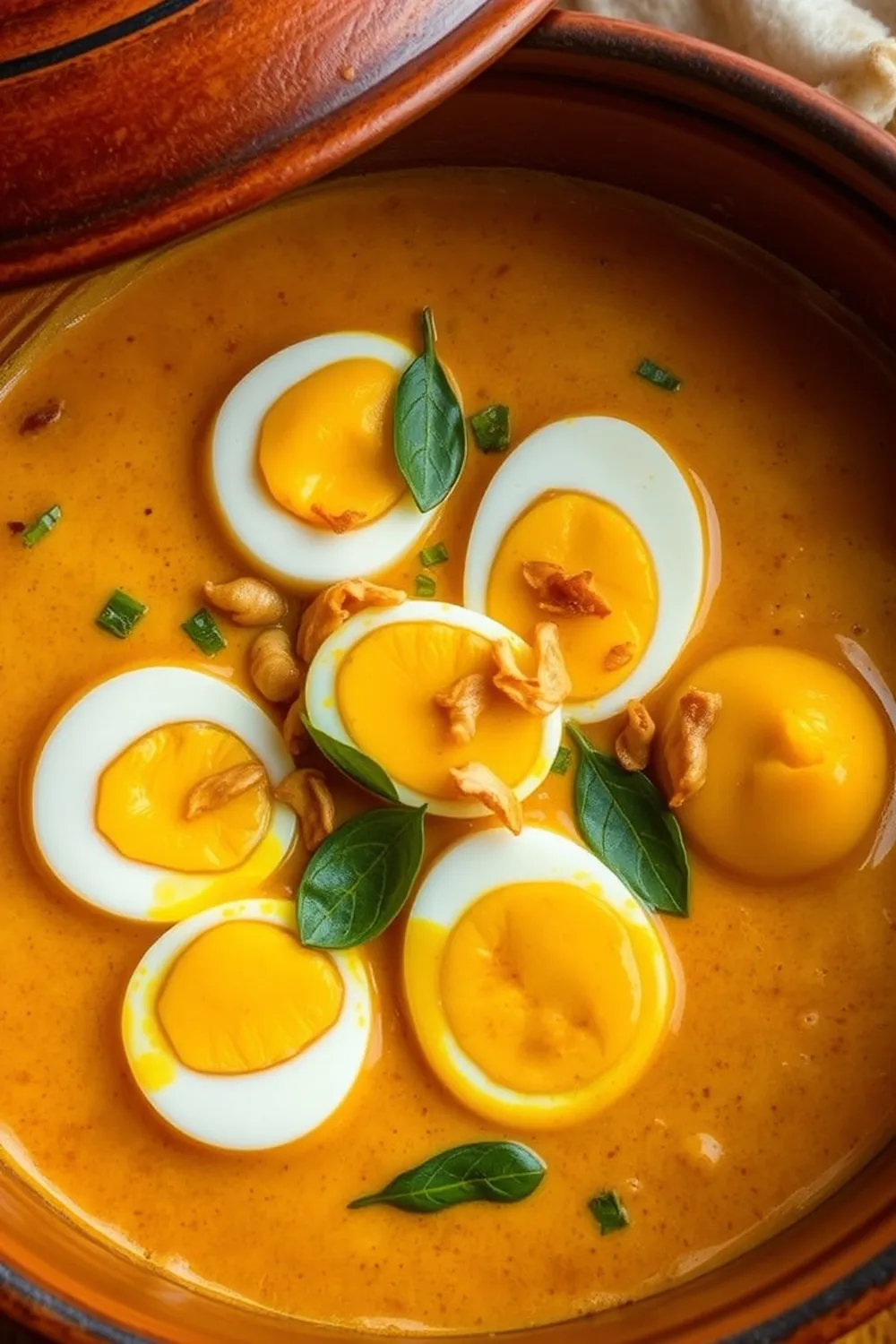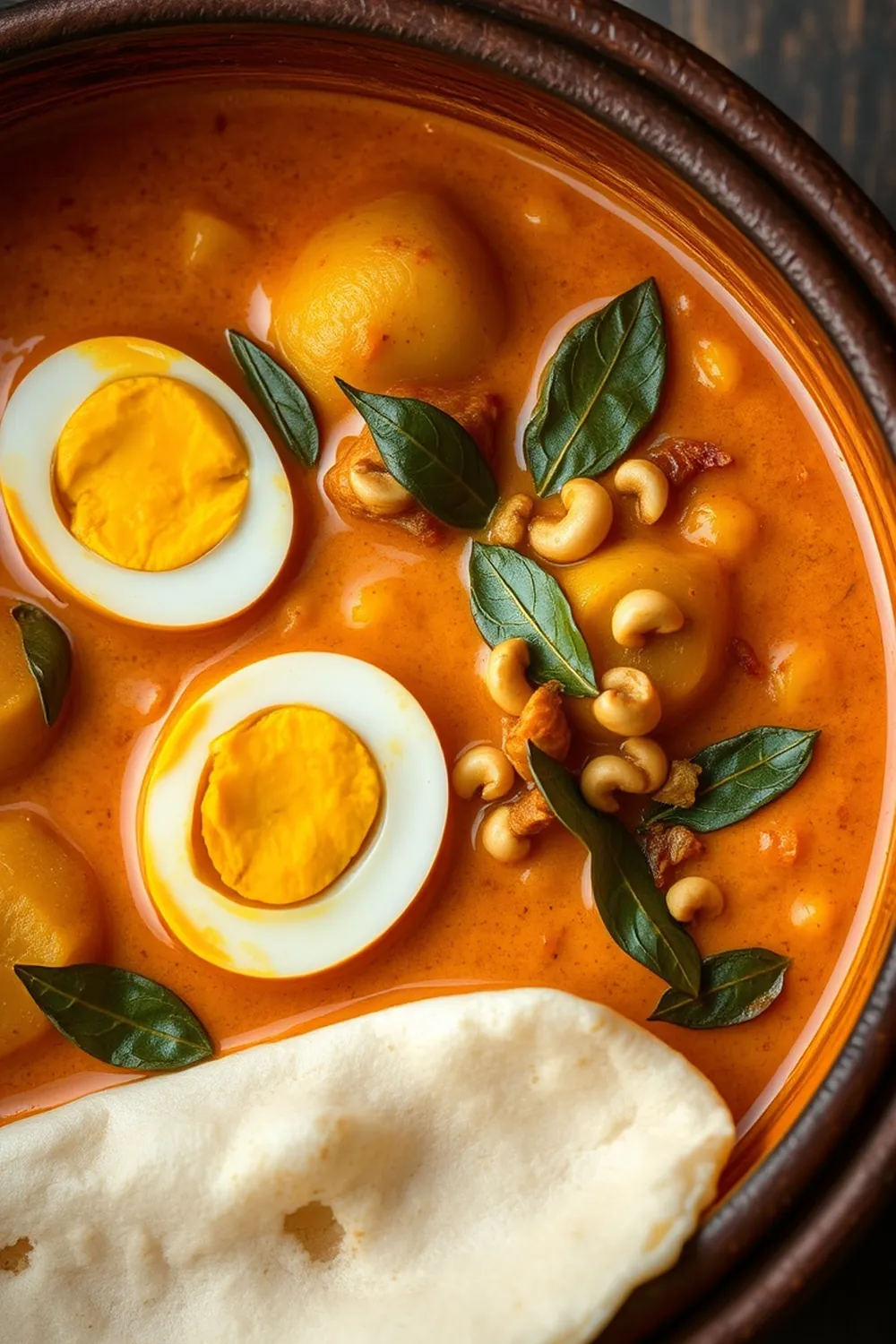- Heat coconut oil in a pan. Add cardamom, cloves, ginger, green chilies, curry leaves, and shallots. Sauté until shallots soften.
- Blend cashews, green chilies, fennel seeds, and water into a smooth paste. Add paste to the pan with 1 cup water. Cook, covered, for 3-4 minutes.
- Add salt, boiled baby potatoes, and hard-boiled eggs (with slashes) to the pan. Pour in coconut milk and simmer for 2 minutes.
- Heat ghee in a tempering pan. Fry sliced shallots and curry leaves until golden brown. Turn off heat, add black pepper, and mix.
- Pour tempering over the stew. Serve hot with appam or idiyappam.
- Calories:350 kcal25%
- Energy:1464 kJ22%
- Protein:10 g28%
- Carbohydrates:35 mg40%
- Sugar:8 mg8%
- Salt:500 g25%
- Fat:20 g20%
Last Updated on 6 months ago by Neha Deshmukh
Kerala Potato & Egg Stew Recipe – Coconut Milk & Spices
Introduction
Oh, this stew! It’s pure comfort in a bowl, and it instantly transports me back to my trips to Kerala. The creamy coconut milk, the gentle warmth of the spices… it’s just heavenly. I first made this when I was trying to recreate a dish I’d had at a small family-run restaurant in Kochi, and honestly, it took a few tries to get it just right. But now? It’s a family favorite, and I’m so excited to share it with you. This Kerala Potato & Egg Stew is a beautiful blend of flavors, and it’s surprisingly easy to make.
Why You’ll Love This Recipe
This stew isn’t just delicious; it’s special. It’s a wonderfully comforting dish that’s perfect for a cozy night in. It’s also a fantastic way to experience the unique flavors of Kerala cuisine. Plus, it’s relatively quick to prepare – ready in about 30 minutes! It’s a great option for a weeknight meal or a special occasion.
Ingredients
Here’s what you’ll need to create this Kerala masterpiece:
- 2 tablespoons coconut oil
- 3 cardamom pods
- 4 cloves
- 1 tablespoon ginger, finely chopped
- 2 green chillies, chopped
- 2 curry leaves sprigs
- ¼ cup Indian shallots, sliced
- 1 cup water (plus an extra ¼ cup for the cashew paste)
- 1 teaspoon salt
- 500 grams baby potatoes, boiled and peeled
- 4 eggs, hard boiled
- 1 cup thick coconut milk
- 15 cashews
- 4 green chillies
- ½ teaspoon fennel seeds
- 1 teaspoon ghee
- 2 tablespoons Indian shallots, sliced
- ½ teaspoon black pepper powder
Ingredient Notes
Let’s talk ingredients! Getting these right will really elevate your stew.
Coconut Oil: Choosing the Right Kind
I always use virgin coconut oil for this recipe. It has a lovely aroma and a subtle coconut flavor that really shines through. You can use refined coconut oil if you prefer a more neutral taste, but I find the virgin oil adds so much character.
Cardamom & Cloves: The Heart of Kerala Spices
These spices are essential for that authentic Kerala flavor. Use green cardamom pods – they’re more fragrant than black. And don’t skimp on the cloves!
Indian Shallots: A Regional Specialty
Indian shallots (also known as chukka uppu) are smaller and sweeter than regular shallots. They add a unique depth of flavor. If you can’t find them, you can substitute with regular shallots, but try to use red shallots for a slightly sweeter taste.
Cashews & Fennel Seeds: Flavor Building Blocks
These might seem like unexpected additions, but they create a wonderfully creamy and aromatic base for the stew. Don’t skip them!
Thick Coconut Milk: Importance of Quality
This is crucial. You want thick, full-fat coconut milk for the best results. The canned variety works great, just make sure it’s a good quality brand. Freshly squeezed is even better if you can get your hands on it!
Step-By-Step Instructions
Alright, let’s get cooking!
- Heat the coconut oil in a pan over medium heat. Add the cardamom pods, cloves, chopped ginger, green chillies, curry leaves, and sliced shallots. Sauté until the shallots soften and turn golden brown – about 3-5 minutes. This is where the magic begins!
- While the shallots are sautéing, let’s make the cashew paste. Blend the cashews, green chillies, fennel seeds, and ¼ cup of water into a super smooth paste. You might need to add a little more water to get it going.
- Add the cashew paste to the pan with the sautéed spices. Pour in 1 cup of water and cook, covered, for 3-4 minutes, stirring occasionally. This allows the flavors to meld together beautifully.
- Now, add the salt, boiled and peeled baby potatoes, and the hard-boiled eggs (I like to give them a few gentle gashes so they absorb more flavor). Pour in the thick coconut milk and simmer for another 2 minutes. Don’t let it boil vigorously, or the coconut milk might split.
- While the stew simmers, let’s prepare the tempering. Heat the ghee in a small pan. Fry the sliced shallots and curry leaves until they’re golden brown and crispy. Turn off the heat and stir in the black pepper powder.
- Finally, pour the tempering over the stew. Give it a gentle stir and serve hot with appam or idiyappam.
Expert Tips
- Don’t overcook the potatoes! They should be tender but still hold their shape.
- For a richer flavor, you can add a pinch of turmeric powder to the stew.
- If you’re using large potatoes, cut them into bite-sized pieces before boiling.
Variations
- Vegan Adaptation: Swap the ghee for coconut oil in the tempering and omit the eggs. You can add some chickpeas or tofu for extra protein. My friend Priya makes a fantastic vegan version with roasted cauliflower!
- Gluten-Free Adaptation: This recipe is naturally gluten-free! Just double-check the ingredients you’re using to ensure they haven’t been processed in a facility that also handles gluten.
- Spice Level Adjustment: Adjust the number of green chillies to your liking. If you’re sensitive to spice, start with just one.
- Festival Adaptations (Onam, Vishu): This stew is a classic part of a Kerala sadya (festive meal). It’s often served as part of Onam and Vishu celebrations.
Serving Suggestions
This stew is traditionally served with appam (lace-edged pancakes) or idiyappam (string hoppers). But it’s also delicious with rice, roti, or even crusty bread for soaking up all that lovely sauce.
Storage Instructions
Leftovers can be stored in an airtight container in the refrigerator for up to 3 days. Reheat gently on the stovetop or in the microwave. The flavors actually develop even more overnight!
FAQs
What is the origin of Kerala Potato & Egg Stew?
This stew is believed to have Portuguese influences, dating back to the 16th century when Portuguese traders arrived in Kerala. They introduced ingredients like potatoes and eggs, which were then incorporated into local cuisine with the addition of Kerala’s signature spices and coconut milk.
Can I use regular potatoes instead of baby potatoes?
Yes, you can! Just make sure to cut them into bite-sized pieces and adjust the cooking time accordingly.
How can I adjust the thickness of the stew?
If you prefer a thicker stew, you can add a teaspoon of cornstarch mixed with a tablespoon of water. Stir it in during the last minute of cooking.
What is the best way to hard boil eggs for this recipe?
I like to place the eggs in a pot of cold water, bring it to a boil, then reduce the heat and simmer for 8-10 minutes. Immediately transfer them to an ice bath to stop the cooking process.
Can this stew be made ahead of time?
Yes, you can make the stew a day ahead of time. The flavors will meld together even more beautifully. Just add the tempering right before serving.









